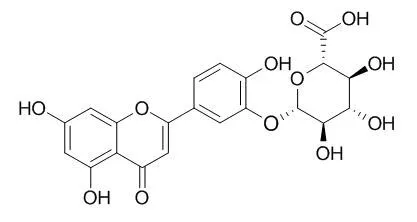A new flavonoid, 6''-O-(E)-feruloylhomoplantaginin (1), and 14 known compounds, 6''-O-(E)-feruloylnepitrin (2), 6''-O-(E)-p-coumaroylnepitrin (3), 6-methoxyluteolin 7-glucopyranoside (4), luteolin 3'-O-beta-D-glucuronide (Luteolin-3-O-beta-D-glucuronide,5), luteolin 3'-O-(3''-O-acetyl)-beta-D-glucuronide (6), kaempferol (7), luteolin (8), genkwanin (9), and ladanein (10), together with 1-O-feruloyl-beta-D-glucopyranose (11), 1-O-(4-hydroxybenzoyl)-beta-D-glucopyranose (12), rosmarinic acid (13), carnosic acid (14), and carnosol (15), were isolated from the leaves of Rosmarinus officinalis .
METHODS AND RESULTS:
The structures were established on the basis of NMR spectroscopic methods supported by HRMS. All isolated compounds were tested for cytotoxicity in human cancer cell lines (HepG2, COLO 205, and HL-60) and for anti-inflammatory activities in lipopolysaccharide (LPS)-treated RAW 264.7 macrophage cells. Among them, compounds 14 and 15 were modestly active in the inhibition of nitrite production in macrophages, followed by compounds 8 and 5. Compounds 14 and 15 were more effective as an antiproliferative agent in HL-60 cells with IC(50) values of 1.7 and 5.5 microM, followed by compounds 8 and 7 with IC(50) of 39.6 and 82.0 microM, respectively. In addition, compounds 14 and 15 showed potent antiproliferative effects on COLO 205 cells with IC(50) values of 32.8 and 29.9 microM, respectively. |






 Cell. 2018 Jan 11;172(1-2):249-261.e12. doi: 10.1016/j.cell.2017.12.019.IF=36.216(2019)
Cell. 2018 Jan 11;172(1-2):249-261.e12. doi: 10.1016/j.cell.2017.12.019.IF=36.216(2019) Cell Metab. 2020 Mar 3;31(3):534-548.e5. doi: 10.1016/j.cmet.2020.01.002.IF=22.415(2019)
Cell Metab. 2020 Mar 3;31(3):534-548.e5. doi: 10.1016/j.cmet.2020.01.002.IF=22.415(2019) Mol Cell. 2017 Nov 16;68(4):673-685.e6. doi: 10.1016/j.molcel.2017.10.022.IF=14.548(2019)
Mol Cell. 2017 Nov 16;68(4):673-685.e6. doi: 10.1016/j.molcel.2017.10.022.IF=14.548(2019)